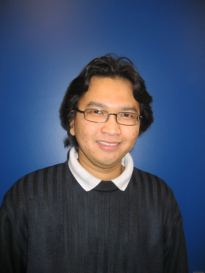Integral design of a laser wakefield accelerator with external bunch injection
Promotion date: 2. April 2009
Promotor: Prof. Dr. K.-J. Boller
Co promotor: Dr. Ir. F. A. van Goor
| This thesis describes the modelling, design and setup of an experiment which aims on the first demonstration of laser wakefield acceleration with external bunch injection. In this injection scheme, an electron bunch provided by a conventional linear accelerator is injected into a plasma channel shortly before the arrival of a high-intensity ultra-short laser-pulse. In the channel, the bunch would be overtaken by the laser pulse. Subsequently, the excited wakefield following the laser pulse traps, compresses the bunch to a size of a few micrometers and, then, accelerates it to ultra-relativistic energies. Such bunches possess unique properties which can open the way for subsequent research steps in the forefront of relativistic interaction of light with matter. |
What is special about the method proposed in this thesis?
To inject the electron bunch into the plasma, before the laser pulse has arrived, is a contra-intuitive idea. The introduction of this injection scheme is a whole new method.
During my project I had two special moments, one could say. I started the project with clear optical tables, and the first step was to construct a high-power laser system. It was a nice feeling to show that we now, at the Twente University, have a 12 Terawatt laser system, which generates 480 milliJoules per pulse with a duration of 40 femtoseconds. Nowadays, a commercially comparable laser costs of about two million euros.
The second reward was the controlling of the small linear accelerator. It was a special moment when I observed flashlight when electron beams hit a phosphor screen installed on the beam path. I succeeded doing so around Christmas 2007. I remember this very well.
Do you expect this method is going to be used by researchers all over the world?
I hope so, of course. But a lot of work has still to be done. The main problem is to control the injection and the acceleration process. The injected electrons and the laser wakefield need to be well overlapped in space and to be well synchronized in time.
On the other hand, theoretical predictions are very promising. It would be possible to create a small size accelerator, which can accelerate electrons over a very short distance. This would be a great advantage because of its low cost, and could fit into university-scale laboratories.
What are your future plans?
After the promotion date, I stay in the same group until August 2009 as a post-doc, doing the main experimental work. After that period, I will move to the Forschungszentrum Dresden-Rossendorf (FZD), our collaboration partner in this project, also as a post-doc.
Academic life suits me well. I hope to do several research projects in Europe and in the United States for the coming years. In that way, I can develop a broad knowledge base, gain lots of experience and build an interesting network of experts.
Eventually, I would like to go back to my native country of Indonesia, bringing technology to the people and, in doing so, help to develop our country. I believe I can contribute to that goal at some time in the future, giving young people chances to develop their talents all over the world.
Are there, in your opinion, new chances for MESA+ in the future?
A lot of special expertise areas already exist and the facilities are great. It would be exciting, when different groups find common interests and work more closely together on new-shared issues.

